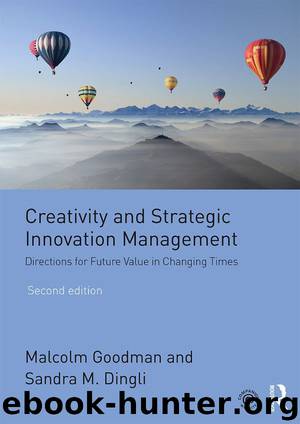Creativity and Strategic Innovation Management: Directions for Future Value in Changing Times by Malcolm Goodman & Sandra M. Dingli

Author:Malcolm Goodman & Sandra M. Dingli [Goodman, Malcolm]
Language: eng
Format: azw3
Publisher: Taylor and Francis
Published: 2017-03-31T04:00:00+00:00
p.155
Samsung has long emphasised the need for creativity while hiring more foreign talent, as it operates in increasingly diverse markets. Along with relaxed rules on work hours, it stresses a ‘Work Smart’ philosophy to reduce unnecessary time spent at the office. While it’s hoped a looser environment will help stir new ideas, some insiders say progress is slow against what is often described as an entrenched culture of rigid, top-down management. ‘Samsung’s doing some soul searching right now, it’s asking itself “who am I, and what should I do next?”’ said Chang Sea-Jin, a business professor at Korea Advanced Institute of Science and Technology.
In the long term, the company needs to become global and open. Giving employees more autonomy requires a new culture and shared leadership approach. For a national culture that is heavily influenced by a Confucian conformist culture the company faces powerful social mindsets. Confucianism is a culture that has deep respect for age. Hierarchy is very important and this poses problems if employees feel that new ideas could be interpreted as challenging their boss. Senior management are aware of this potential constraint and determined to overcome it, whilst also preserving the respect that the Confucian cultural code expects, have established a Creative Lab programme. This permits individuals or in teams take a year to develop an idea if it is deemed worthy of pursuit. Samsung says it had some 14,000 ideas last year through this programme and other company initiatives.
Though widely respected in Korea, Samsung has a reputation for imposing a heavy workload and limiting personal time. This runs counter to its declared aim of accepting the need to provide space and time to boost creativity and innovation and to improve the work–life balance for its employees. The original Theory X management style has morphed into a Theory Y style over the years but now needs to morph again into a Theory Z approach. The succession of a new Chairman provides an opportunity for a new style of leadership that will speed the transition to a fully fledged Theory Z organisation.
Download
This site does not store any files on its server. We only index and link to content provided by other sites. Please contact the content providers to delete copyright contents if any and email us, we'll remove relevant links or contents immediately.
Bad Blood by John Carreyrou(6274)
Rich Dad Poor Dad by Robert T. Kiyosaki(6174)
Principles: Life and Work by Ray Dalio(5961)
Playing to Win_ How Strategy Really Works by A.G. Lafley & Roger L. Martin(5497)
Management Strategies for the Cloud Revolution: How Cloud Computing Is Transforming Business and Why You Can't Afford to Be Left Behind by Charles Babcock(4438)
The Confidence Code by Katty Kay(4036)
Thinking in Bets by Annie Duke(3996)
American Kingpin by Nick Bilton(3507)
Delivering Happiness by Tony Hsieh(3280)
Project Animal Farm: An Accidental Journey into the Secret World of Farming and the Truth About Our Food by Sonia Faruqi(3017)
The Power of Habit by Charles Duhigg(2966)
Brotopia by Emily Chang(2892)
Mastering Bitcoin: Programming the Open Blockchain by Andreas M. Antonopoulos(2891)
The Tyranny of Metrics by Jerry Z. Muller(2846)
I Live in the Future & Here's How It Works by Nick Bilton(2844)
The Marketing Plan Handbook: Develop Big-Picture Marketing Plans for Pennies on the Dollar by Robert W. Bly(2793)
The Content Trap by Bharat Anand(2778)
Building a StoryBrand by Donald Miller(2754)
Applied Empathy by Michael Ventura(2749)
